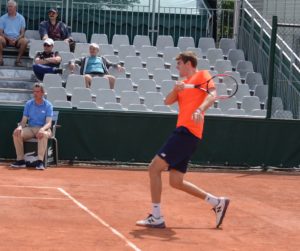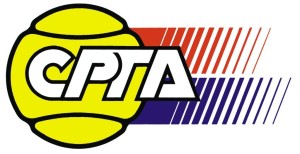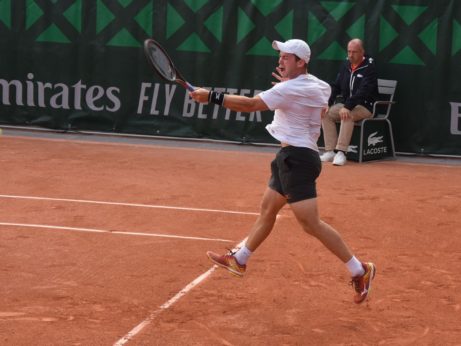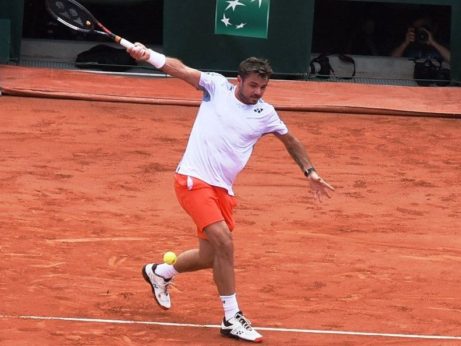The most misleading coaching advice towards stroke production – 2 – Forehand

(Under construction) As there is not just one exact way how to correctly strike a tennis ball in order to win a point and as there are quite big overall margins in tennis, one can find quite some diversity in the ways how different players hit their strokes. The best of the best are then (besides their personal idiosyncrasies) very similar in the crucial/decisive stroke reference points (often not being even exactly aware of them in detail), which are, unfortunately, mainly in regards of the dominant energy source and of the follow through, often also not exactly well known to many coaches and educators. As a result, many educational tennis publications, as well as coaching advice given to players, have often included and still include quite a few myths, which can be very misleading and cause significant limitations in the development of the players as well as lead to serious injuries.
In the Part One of this “most misleading” series published some months ago, I wrote about the terrible misleading instruction advice guiding players to focus at finishing the racket path close to the non-dominant leg while serving, which mostly leads to a sub-optimal body energy release (unloading) against the target and thus limits both power and precisions of the services played with this instruction in mind. In today’s Part Two, I would like to focus on the forehand. Same way like with the service, proper application of the TENNIS 3.0 CODE – mainly its crucial element, the biggest possible distance of the elbow from the core of the body during the “follow through 1” plays an essential role.
But let’s start at the beginning. In general, players, coaches, and observers of the game have often difficulties to properly understand mainly two decisive aspects:
1/ Receiving/absorption of the ball coming from the opponent (besides own serving obviously) is almost more important than own sending/acceleration/striking of the ball – the sometimes mentioned power-position for the stroke must create in the first row to the possibility to absorb the power of the incoming ball without losing own body balance and only then comes the aspect of the body/racket acceleration against the intended target. The greatest players are mostly also the best ball receivers, not just great strikers.
2/ The same way like with the before mentioned service, there is a very significant difference between the active (crucial/decisive) stroke portion, which ends with the “follow through 1” where most of the available body energy has been released/unloaded already, and the rather passive (relaxation) portion starting with “follow through 2”, where most of the stroke energy is gone already and which can, unlike the active portion, have major differences from player to player. This misunderstanding leads to the situation that players are often being advised and programmed based on the reference points in the relaxation phase of the strokes (=follow through 2) and are thus often missing on the crucial/decisive reference points in the active stroke portion, mainly around and after the impact. As a result, the players are developing the wrong image of the ideal stroke in their mind and use this image as the base for their stroke production. This ill-conceived process can start already with small children during their first attempts at hitting of the ball. Even today, most of the children are starting to learn forehand based on the elbow flexion instead of pronation, which is actually easy to teach, when done properly. Such wrong guidance then often continues at the following stages all the way into professional tennis. The main reason behind the wrong instruction is, in my opinion, based on the sometimes even 1-D, but mostly 2-D understanding of the strokes, which is then leading to the Tennis 2.0 execution.
More coming…

Michel Larcher de Brito (*93 / POR) – Forehand 2.0 in a match – racket head speed based on the elbow flexion dominates the stroke – 2010 US.Open – New York / USA – August 2010

Reilly Opelka (*97 / USA) – Forehand in a match – elbow flexion dominates the stroke – 2017 French Open Qualification – Paris / France
This article covers certain aspects of the forehand production only! Further photos, more details (inclusive exact guidance) are available upon request at drmgb11(at)gmail.com. Some significant details of this kind, necessary for a peak tennis performance as well as for a sustainable tennis training/development in general, are being discussed also in the seminar “TENNIS 3.0 – Future of the Game”, which is available worldwide upon request – www.tennis30.com / www.tennis30.cz
Photos/video () & text () copyright by Dr. Martin G. Baroch. Any further publication of either any of the photos/video & and/or texts with the explicit written permission issued by the author/copyright owner only!!



